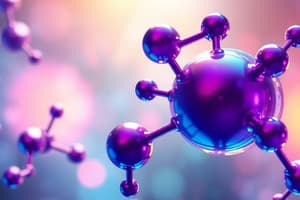Podcast
Questions and Answers
What is the hydroxyl functional group?
What is the hydroxyl functional group?
-OH; Found in sugar/alcohol; Neither basic nor acidic; ends in 'ol'.
What is the carbonyl functional group?
What is the carbonyl functional group?
-C=O-; Found in sugar; Neither basic nor acidic.
What is the carboxyl functional group?
What is the carboxyl functional group?
-C=O-OH; Found in proteins; Acidic.
What is the amino functional group?
What is the amino functional group?
What is the phosphate functional group?
What is the phosphate functional group?
What is the methyl functional group?
What is the methyl functional group?
What are functional groups?
What are functional groups?
What are macromolecules?
What are macromolecules?
What is a polymer?
What is a polymer?
What are carbohydrates (carbs)?
What are carbohydrates (carbs)?
What are proteins?
What are proteins?
What are nucleic acids?
What are nucleic acids?
What is a dehydration reaction?
What is a dehydration reaction?
What is a hydrolysis reaction?
What is a hydrolysis reaction?
What does lysis mean?
What does lysis mean?
What does synthesis mean?
What does synthesis mean?
What does dehydrate mean?
What does dehydrate mean?
What does hydro mean?
What does hydro mean?
What are the functional groups of carbohydrates?
What are the functional groups of carbohydrates?
What is the shape of carbohydrates?
What is the shape of carbohydrates?
What is a disaccharide?
What is a disaccharide?
What are polysaccharides in plant storage?
What are polysaccharides in plant storage?
What are polysaccharides in animal storage?
What are polysaccharides in animal storage?
Flashcards are hidden until you start studying
Study Notes
Functional Groups in Biology
- Hydroxyl (-OH): Present in sugars and alcohols; neutral in terms of pH; compounds ending in “-ol” indicate its presence.
- Carbonyl (C=O): Commonly found in sugars; does not exhibit basic or acidic properties.
- Carboxyl (-COOH): Typically found in proteins; characterized as an acidic functional group.
- Amino (-NH2): Basic group found in proteins; often referred to as "amines."
- Phosphate (OPO3): Present in lipids and nucleic acids; exhibits neutral pH behavior.
- Methyl (-CH3): Associated with DNA; does not affect pH; crucial for DNA activation.
Macromolecules and Their Components
- Functional Groups: Groups of atoms that interact consistently; include six types, with five being polar (hydrophilic) and one being non-polar (hydrophobic).
- Macromolecules: Large molecules formed from repeating smaller units; includes carbohydrates, proteins, and nucleic acids.
- Polymers: Substances consisting of many repeating units called monomers.
Categories and Structures of Carbohydrates
- Carbohydrates: Classified by size; monosaccharides are singular, disaccharides consist of two, and polysaccharides include more than two units.
- Disaccharide Formation: Constructed from two monosaccharides via dehydration reactions.
- Polysaccharides in Plants: Starch serves as the primary storage form; structured in a helical form and comprised of glucose.
- Polysaccharides in Animals: Glycogen functions as the storage polysaccharide; branched structure, stored mainly in the liver and muscles.
Reactions Involved in Macromolecule Formation
- Dehydration Reaction: A synthesis process that joins two monomers by removing -OH from one and H from another, thus forming a polymer.
- Hydrolysis Reaction: A process that disassembles a polymer into smaller units by adding water (H2O).
- Lysis: Term used to describe the act of breaking apart or splitting.
- Synthesis: Refers to the creation or combination of elements to produce a substance.
- Dehydrate: The act of removing water from a compound.
- Hydro: Prefix indicating association with water.
Structural Characteristics of Carbohydrates
- Shape of Carbohydrates: Typically circular (ring) structures, but some may present in linear forms.
- Functional Groups Found in Carbohydrates: Primarily hydroxyl and carbonyl groups.
Studying That Suits You
Use AI to generate personalized quizzes and flashcards to suit your learning preferences.




